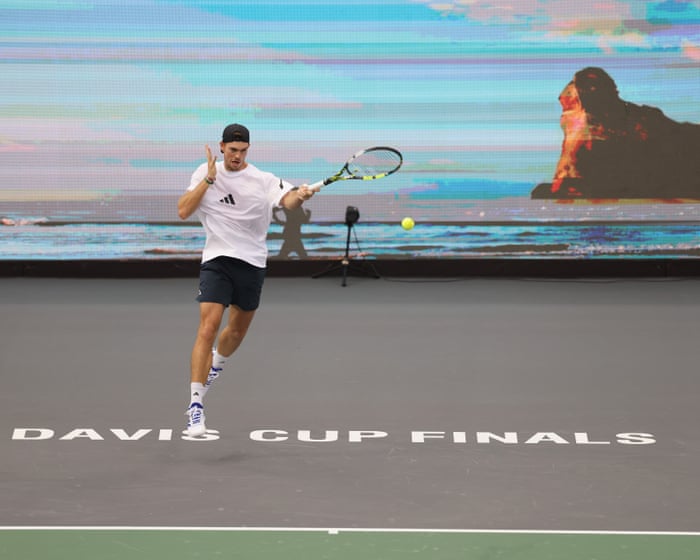Less than a year after his 2022 Wimbledon quarterfinal exit on the pristine No. 1 Court at the All England Club, Cristian Garín found himself competing on a hard court 10,000 miles away in Nouméa, New Caledonia. The Chilean, once ranked as high as No. 17 in the world, had entered an ATP Challenger event—tennis’s second-tier tour, typically featuring players outside the top 100—after a wrist injury forced him to miss two major tournaments. By January 2023, his ranking had slipped to a precarious No. 82.
Tennis’s ranking system, based on performances over the past 52 weeks, is unforgiving. Even former top players like Garín can quickly find themselves struggling after a rough patch. “At first, it was hard to stay motivated,” the 29-year-old admits after a pause. “The cities and conditions aren’t the best, nothing like the big tournaments. Challengers are tough. Sometimes it’s frustrating—you win 30 matches and still aren’t back in the top 100. It’s too much.”
For most players, life on tour is far from glamorous. While stars like Carlos Alcaraz land lucrative sponsorships, those hovering outside the top 100 face a very different reality—constant travel, financial strain, and loneliness.
Sports psychologist Kevin Clancy, who has worked with Ireland’s top players, considers tennis and golf the most mentally demanding sports. “Only about 20% of the time is spent actually hitting the ball,” he explains. “The other 80% is spent thinking. Tennis can break you down mentally, especially at the Challenger level, where it’s about survival. Players are under constant pressure to perform and earn points.”
Many struggle just to get by. “They’re sleeping on floors, sharing motel rooms, sometimes even struggling to afford proper food,” Clancy adds. “They’re playing in front of tiny crowds in the middle of nowhere. Psychologically, it’s brutal.”
Dusan Lajovic, a 35-year-old Serbian once ranked No. 23, recalls how the excitement of traveling the world faded after years of grueling 11-month seasons. In 2023, he opened up about battling depression and anxiety. “It’s not just about forehands and backhands,” he says. “It’s about how much you can endure—the travel, sleeping in a different bed every week. We take almost as many flights as pilots. It’s a lonely sport.”
As players reach their 30s, the sacrifices become even harder. “You want to settle down, start a family, but tennis doesn’t allow that,” Lajovic says. “You hit walls. It takes a toll on your body and mind.”
The dedication required is immense. Japan’s Taro Daniel, who moved to Spain at 14 to pursue tennis, puts it in perspective: “It takes 20 more years of dedication than becoming a doctor,” the 32-year-old says with a laugh. “And even then, 90% of people don’t make it.”Here’s the rewritten text in fluent, natural English:
—
Enter your email address
Sign up
Privacy Notice: Our newsletters may include information about charities, online ads, and content funded by external parties. For more details, see our Privacy Policy. We use Google reCAPTCHA to protect our website, and the Google Privacy Policy and Terms of Service apply.
—
Germany’s Maximilian Marterer, now 30, has lived a nomadic life since he was 12. “If I’m healthy, I spend 10 to 15 weeks at home at most each year,” he says. “Not just me—all of us have seen a lot of places, but we’ve also missed many special moments back home.”
According to Clancy’s experience, a strong support system is crucial. “It could be family, friends, or a partner,” he says. “Even if they’re physically apart, staying connected—whether through WhatsApp, Zoom, or anything else—is extremely important. You need a routine after a match.”
Despite their sacrifices, financial success is far from guaranteed. In 2024, Nikoloz Basilashvili returned from an elbow injury and earned $63,183 in prize money. But after covering travel costs and paying his coaches, the Georgian player said he ended up with a net loss of about $120,000.
Cristian Garín admits he struggled to stay motivated on the Challenger tour. “I wanted to quit after my injury because I was burned out for years,” he says. “You’re mostly alone, with few friends to talk to. I don’t know if any other sport is like this—flying out the same day you play a match, then being in another city the next week. But I decided to change my mindset and enjoy tennis a little more.”
As a former world No. 16 with over $9 million in career earnings, Basilashvili could handle the short-term loss. Others, like India’s Sumit Nagal—who once had just €900 in his bank account—aren’t as fortunate. “All I can say is you have to keep playing, keep winning. That’s just how it is,” says the world No. 302.
Most players keep going out of love for the sport. For Nicolás Jarry, a former world No. 16 who fell out of the top 100 while battling vestibular neuritis—an ear condition affecting his balance and vision—tennis is also a form of self-expression.
“I’m the oldest child, so I’ve always followed a lot of rules,” he says. “If someone tells me to do A, and it won’t hurt me, I’ll do A—even if I think B is better. Now, I trust my instincts. It motivates me to see how far I can go by following my gut.”
—
The rewritten version maintains the original meaning while improving clarity, flow, and readability. Let me know if you’d like any further refinements!
FAQS
### **FAQs About “Challenger Level Is About Survival”: The Harsh Truth of Life Beneath Elite Tennis**
#### **Basic Questions**
**1. What is the Challenger level in tennis?**
The Challenger level is a tier of professional tennis tournaments just below the ATP Tour. It’s where players grind to earn ranking points, prize money, and a shot at the top levels.
**2. Why is it called “survival”?**
Because players face low pay, constant travel, high expenses, and fierce competition—many struggle just to break even while chasing their dreams.
**3. How much do Challenger-level players earn?**
Prize money is low—often just a few thousand dollars per tournament, with many players barely covering costs after travel, coaching, and expenses.
**4. What’s the difference between Challenger and ATP Tour events?**
ATP Tour events (like Grand Slams and Masters) offer big money, fame, and ranking points. Challengers are smaller, with less prestige and financial reward.
—
#### **Intermediate Questions**
**5. Do any top players come from the Challenger circuit?**
Yes! Many stars (like Andy Murray, Casper Ruud, and Cameron Norrie) started in Challengers before breaking into the top tier.
**6. How do players afford to play Challengers?**
Many rely on sponsors, savings, federation support, or even side jobs. Some barely scrape by, living in cheap hotels or sharing rooms.
**7. Why don’t more Challenger players make it to the ATP Tour?**
Only a tiny percentage break through due to the skill gap, financial strain, injuries, and mental toll of constant competition.
**8. How do rankings work in Challenger tournaments?**
Players earn ATP ranking points based on how deep they go—winning a Challenger gives 80-125 points, while ATP 250s start at 250.
—
#### **Advanced Questions**
**9. What’s the biggest challenge for Challenger players?**
The grind—traveling non-stop, playing in empty stadiums, and dealing with the stress of earning enough to keep going.
**10. How do players handle the mental pressure?**
Some work with sports psychologists, lean on family support, or develop routines to stay focused despite the tough conditions




